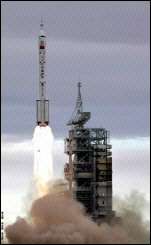Storm In A Spacecraft

Like a salvo of shots, another round of Chinese statements on their space program has filled the media. After so many interesting revelations in February and March, China should have been happy to suspend commentaries on the Shenzhou program for a while. In fact, the opposite has happened.
China's recent media statements suggest that its human spaceflight program is far from settled, and some details are still subjected to extreme volatility.
The most solid statements simply reaffirm China's ongoing commitment to performing a spacewalk from Shenzhou 7, which was re-scheduled this year to 2008. It seemed likely that this mission would use the large, cylindrical Orbital Module at the front of the spacecraft as an airlock. Soviet cosmonauts did this in the first spacewalk from a Soyuz, and the design parallels with Shenzhou are obvious.
But China's statement of an "individual pressure cabin" for the spacewalk strongly suggests that an airlock system will be used, and the Orbital Module is the obvious candidate for this. China has also stated that spacewalk training includes "preparing... skills to operate apparatus and install facilities" in outer space. This suggests that China's first spacewalker will have more to do than just float around and wave at cameras.
Earlier, your correspondent speculated that the first EVA would involve the retrieval of a sample pack from the exterior of the spacecraft, probably on the side of the Orbital Module. This speculation is reinforced by the latest Chinese statements.
No surprises for the next mission have emerged. But Chinese officials have made some eyebrow-raising remarks on other aspects of the program.
The recent US tour of Luo Ge, a vice-administrator at the Chinese National Space Administration, has been surprisingly controversial. Previous visits by Chinese space officials to the USA, including a visit by Chinese astronaut Yang Liwei, have been relatively low-key and quiet, presumably in an effort to avoid excessive controversy. Luo has certainly bucked that trend.
The Chinese delegate was apparently serious when he accused the USA of a lack of openness in its society and space program, and seemed to insinuate that China was making better progress in opening its own space program to the world. "Countries should be open," said Luo in a syndicated story.
In such a case, your correspondent would be happy to see the incredible stonewalling that has hidden most aspects of Shenzhou from the world disappear. Your correspondent would also like to know if a brainwashing experiment has given Luo false memories of his previous access to NASA personnel, information and facilities.
The apparent goal of Luo's barbs has been some sort of attempt to gain access to the US space program. China has been knocking on NASA's door for some time, and has an interest in the International Space Station. But actions like this are unlikely to heal the already frosty relationship between the nations. What does China want to do? Send Shenzhou to ISS? The chances of this happening are growing slimmer, especially when the US Government is currently fretting over China's rapid gains on the USA in space.
Chinese astronauts may not visit ISS for some time, if at all, but their chances of flying to an indigenous space station could be a bit stronger. For some time, aerospace writers have speculated that the Long March 5 heavy lift rocket, long touted as the workhorse for future lunar and space station programs, was on hold.
A recent reshuffle of the Shenzhou mission plans after Shenzhou 7 seemed to reinforce this. But now Luo Ge has described plans for a "non-polluting" launch vehicle that can lift 25,000 kg into orbit by 2010.
Has the Chinese space stallion finally bolted from the gate? The use of "non-polluting" fuels suggests a vehicle powered by kerosene and liquid oxygen, or liquid hydrogen and liquid oxygen. The fuel mix, and the suggested payload mass, are consistent with previous reports of the Long March 5. But 2010 isn't far away. Can the Chinese really roll out this monster rocket by then?
One consequence of the apparent introduction of the Long March 5 is China's potential for sending astronauts to the moon. In an earlier article, your correspondent speculated that the Shenzhou 8-9-10 orbital complex could be a rehearsal for a translunar mission, which would carry Chinese astronauts around the moon without landing.
Another interpretation of the 8-9-10 mission plan was that China simply wanted to build a miniature space station, as the lack of the Long March 5 prevented the launch of a larger one. If China gets a Long March 5 heavy lifter soon, it will diminish the case for the miniature space station and reinforce suggestions that an Earth Orbit Rendezvous strategy is being used to reach the moon.
What is China really doing? Nobody outside the program seems to know, and the frequent changes in official statements suggest that the Chinese themselves could still be unsure. It seems that plans could be in a state of flux while China waits for America to respond to its overtures. This could take some time. For the moment, the short-term future of Chinese human spaceflight is a very open question.
Dr Morris Jones is a lecturer at Deakin University, Australia.
Copyright 2006 by Space Daily, Distributed United Press International



















